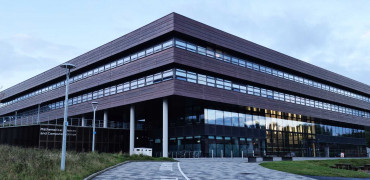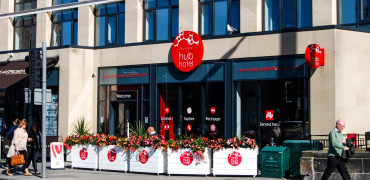If you know anything about air conditioning then you will know that today’s modern buildings are highly likely to use what is known as VRF systems, which refers to the Variable Refrigerant Flow (VRF) that the equipment utilises to transfer heating and cooling around a room, a space, or an entire building.
VRF systems have become incredibly popular because they provide market-leading levels of efficiency that help reduce running costs. In addition, flexibility in design and the ability to fit units in a modular fashion reduces installation costs. Overall, Hybrid VRF offers convenience as it comes as a complete package solution, from the stylish choice of indoor units to a complete controls package.
Our market leading VRF is the City Multi range, which is a direct expansion type air conditioning system where one outdoor unit is connected with multiple indoor units.
The system intelligently modulates the flow of refrigerant depending upon the capacity for heating or cooling requirements in each zone within a building.
Its ultimate purpose is to regulate the internal room air temperature and comfort levels effectively and efficiently.
We believe there is no limitation with Hybrid VRF and the possibilities are endless
One or both
Constant development and innovation mean that City Multi VRF can be applied as both Heat Recovery and Heat Pump systems.
Heat Recovery Systems
Heat recovery systems provide simultaneous heating and cooling with the benefit of heat recovery. By moving energy where it’s needed, power input is reduced by up to 30%, offering flexibility, operability, comfort and control. These systems are ideal for hotels, offices, and leisure facilities where there are different heating and cooling requirements throughout the building.
Heat Pump Systems
One outdoor unit provides all indoor units heating or cooling at a given time, making this system ideal for open plan offices, call centres or retail units.
So, what is HYBRID VRF?
There are situations though, where you may not want refrigerant piping in parts of a building, and this is where Hybrid VRF comes into it’s own.
Hybrid VRF, or otherwise knowns as HVRF, is an innovative air conditioning system unique to Mitsubishi Electric, whereby the outdoor unit is connected with a 2-pipe heat recovery VRF system, and water is used between the Hybrid Branch Controller (HBC) and indoor units - instead of refrigerant.
With water pipework connecting the indoor units, Hybrid VRF provides comfortable and stable air temperature control with no refrigerant in occupied spaces, meaning simple compliance with BS EN378 and removing the need for expensive leak detection.
Where can HVRF be applied?
Buildings around the UK have a high priority when it comes to energy efficiency, internal comfort and an easy control solution. We believe there is no limitation with Hybrid VRF and the possibilities are endless.
Customer comfort is paramount with legislation focusing attention on energy use and seeking to limit the use of refrigerant in occupied spaces. Hybrid VRF removes the need for leak detection thereby reducing the total cost of the system and on-going maintenance of the leak detection systems itself.
Modern offices and commercial buildings need air conditioning systems that provide the highest levels of comfort and freshness, as energy efficiently as possible. Furthermore an office can simply be transformed from a CAT A to a CAT B fit out as water pipes can easily be isolated from the Hybrid Branch Controller box making building layout changes simple.
With regards to patient’s health and safety, this system has no refrigerant in the indoor units and at the same time it can deliver mild off-coil temperatures through the water-based Hybrid VRF indoor units.
Providing comfort through temperature stability, removal of refrigerant from the occupied space and reduced noise - Hybrid VRF provides a truly integrated solution.
With other refrigerant based VRF systems, individual leak detectors need to be installed at floor level in each room
Keep it simple and avoid the expense of leak detection
With other refrigerant based VRF systems, individual leak detectors need to be installed at floor level in each room, which not only adds expense, but can also ruin the aesthetics of the décor. This is a requirement of BS EN378 because the detectors need to be where any leaked refrigerant can stagnate.
In addition, these leak detectors need checking and calibrating every year as part of the maintenance regime – every single one of them.
Generally, semiconductor-based leak detection sensors are prone to false alarms, when they detect concentrations of chemical substances such as perfume, deodorant or paint. This can then cause nuisance to occupants in hotel rooms, for example, or while changing the interior of a building from CAT A to CAT B.
In addition to this, next year the F-Gas phase down calls for an additional drop of 14% in the quota of HFC’s on the market, which is likely to lead to an increase in the cost of higher GWP refrigerants and potentially limit their availability.
Future proofing
HVRF proves the ideal solution for customers looking to future-proof their air conditioning in line with the next stage of the F-Gas Regulations and the phase down of high Global Warming Potential (GWP) refrigerants. As a system, Hybrid VRF provides the perfect solution for both reducing refrigerant volume and utilising the lower GWP refrigerant.
By combining R32 with the merits of a Hybrid system, more than an 80% reduction in CO2 equivalent can be achieved as it uses up to 40% less refrigerant, when compared to an R410A VRF system.
With our own targets to reach Net Zero by 2050, both operational and embodied carbon need to be addressed while considering the total emissions of a building over its lifetime. With HVAC components playing an integral part in the built environment, the data with regards to embodied carbon plays an important role while estimating the whole life carbon of a building.
At Mitsubishi Electric, we’ve been leading the way in declaring the full embodied carbon of our equipment and have data to show that Hybrid VRF has a 70% lower embodied carbon than traditional VRF systems.
We publish the calculations and full methodology on Page 19 of our Embodied carbon brochure.
Vertical HBC
Thanks to the new vertical main HBC, City Multi HVRF can be installed in more applications than ever before.
This is a floor standing solution, with all the key components accessible from the front and at floor level during commissioning.
The installation of additional water-side ancillaries such as expansion vessel, water filling loop and isolation valves is also simpler, as they are all located at floor level.
For systems with outdoor units larger than 40kW, the Vertical HBC offers a more cost effective solution which is simpler to install than the Horizontal HBC system.
Come and talk to one of our experts to find out more about City Multi HVRF.
Jobin Varghese is Product Manager for VRF and HVRF air conditioning systems




